| Type |
Single seat glider |
Single seat motorglider |
| Engine |
None |
1 DKW 14 hp |
| Dimensions |
Length 6,15 m, height 1,70 m, span 8,50 m, wing area 15,00 m2, aspect ratio 4,8 |
Length 6,00 m, height 1,75 m, span 8,00 m, wing area 16,00 m2, aspect ratio 4,0 |
| Weights |
Empty 125 kg, flying weight 200 kg, pilot 75 kg, wing loading 13,3 kg/m2 |
Empty 170 kg, flying weight 260 kg, fuel 12 kg, oil 3 kg, pilot 75 kg, wing loading 16,2 kg/m2 |
| Performance |
Max.. speed |
Endurance 2,5 h |
| Type |
Werk.Nr |
Registration |
History |
|
301 |
D-1351 |
First flight 15 March 1927. Registered April 1928. Raka, Kassel. Withdrawn from use April 1932 |
|
302 |
D-1379 |
June 1928. Ostpreussiche Flugbetrieb, Elbing. Withdrawn from use April 1932 |
|
303 |
D-1392 |
May 1928. Raka, Kassel. Withdrawn from use April 1932 |
|
305 |
D-1352 |
April 1928. Raka, Kassel. Withdrawn from use April 1932 |
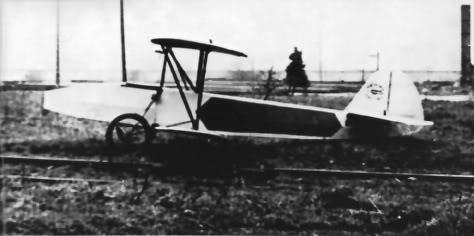
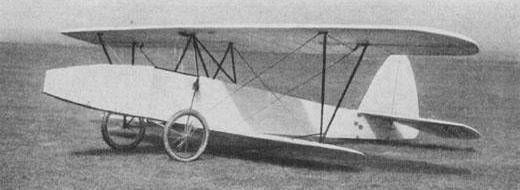
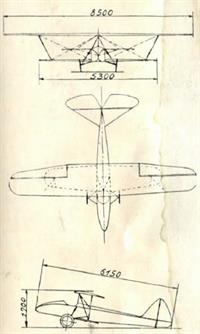
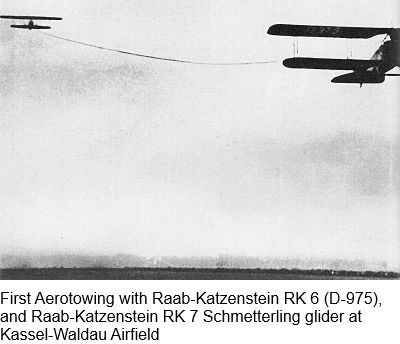
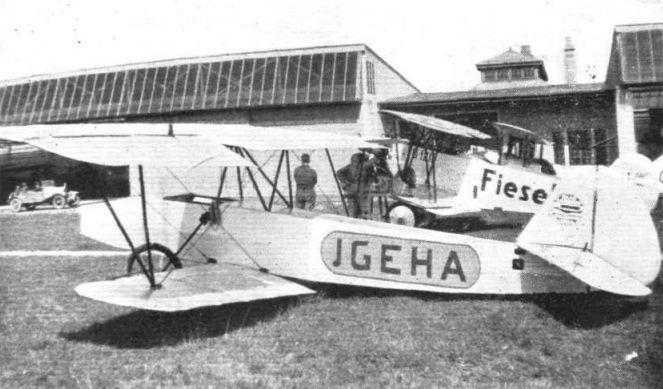
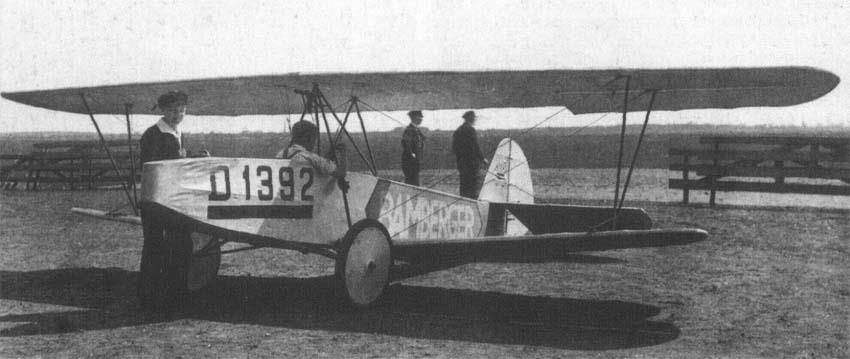
The RK-7 Smetterling was built in three weeks for the well-known chocolate manufacturer Johann Gottlieb HAUSWALDT, from Magdeburg (Germany), whose logo was JGEHA (short for his name). It was used to make one of the very first take-offs in tow of an airplane. Antonius RAAB at the command of the glider was towed by Kurt KATZENSTEIN flying a Raab-Katzenstein RK-6 Kranich (D-975), on March 15, 1927 [other date April 18, 1927?] on the Kassel-Waldau airfield.
During the international airshow in Zurich, Switzerland, which took place from August 12 to 21, 1927, this glider was repeatedly towed by a Fieseler aircraft, then dropped. Each time he came to land right in front of the judges.
Source: Aerokurier 1970
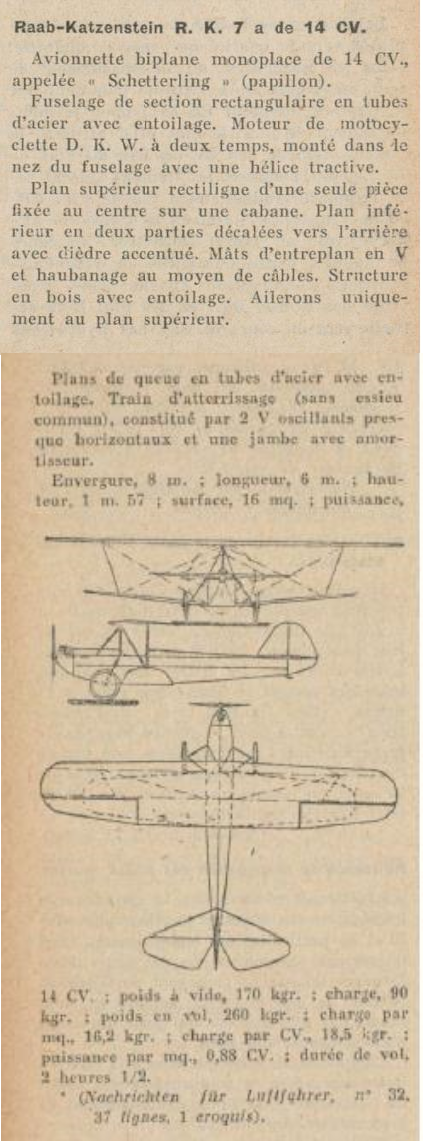

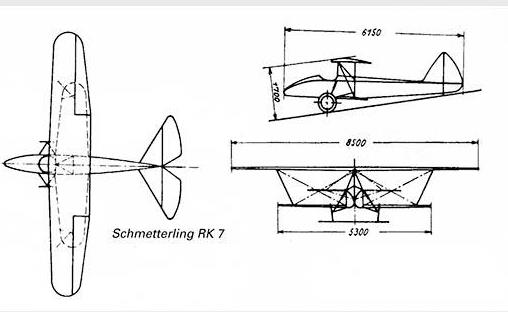


Glider and motor glider RK 7 Butterfly
Antonius Raab writes about this: "The airplane with a trailer is an idea of Fokker, who received a patent for it in 1912. He never used the idea, however. Fokker allowed the Raab-Katzenstein works to exploit his patent in practice. - Since the factory did not own a glider, one was rented from Espenlaub. It had been built without any static calculations, however. That was still the case back then! As soon as the rope was pulled, before the ground was even left, the tail unit flew off and Espenlaub released. That was in March 1927.
The air police wrote a report about it. Within three weeks, the Raab-Katzenstein works designed and built the Butterfly, which will be discussed in more detail below. The first actual tow flight in the world was carried out with it on April 13, 1927. Katzenstein towed with Kranich and Raab sat in the glider Schmetterling. Everything worked out excellently. The factory then applied for a utility model, which was granted in class B 62 under number 993 828. The press published detailed reports on the tow. Soon afterwards Raab and Katzenstein were flying with two trailers behind a towing machine. Katzenstein wrote a newspaper article entitled "The Future Air Railway," which the Hearst Press bought for $400. The first cross-country flight of a tow train from Karlsruhe to Kassel soon followed. Benz was the pilot in the tow train, Raab in the trailer. These flights attracted international attention.
Even representatives of Russian aviation turned up, had everything demonstrated to them, asked for original drawings and promised to buy. They copied, but did not buy. Then an adjutant of Mussolini, Captain Pietro Negri, appeared and the Italians bought two tow systems. The retired general Nanini, who is still alive in Rome, carried out the first flights in Italy. Finally the Americans came, including the later famous air force general Arnold. They bought the entire tow train, plus three pilots "on loan*1. The head of the delegation was the Ra-Ka flight instructor Wenderoth. This team went to the USA and demonstrated tow flying for months. It was financed by the military."
The butterfly had a rectangular fuselage made of tubular steel with fabric covering. The pilot sat under the upper wing. The upper wing was straight, consisted of one piece and sat on a canopy. The much smaller lower wing was swept backwards. Ailerons were only on the upper wing. The tail unit consisted of a tubular steel construction with fabric covering. The undercarriage was hinged to the lower edge of the fuselage on the side without a continuous axle. It was supported against the upper edge of the fuselage by a third strut with springs. The arrangement of the towing device was interesting. It was attached to the top of the canopy of the tow plane and passed over the tail unit by a tube over a tubular steel bracket. The tow rope was attached to the nose of the tow plane itself in a releasable manner. Both pilots had a release device.
The aircraft was experimentally equipped with an auxiliary engine, namely a two-stroke bicycle engine, in the nose of the fuselage under the designation RK 7a. The RK 7a differed in its dimensions from the glider and had a larger span of the upper wing. The lower wings had a strong V-shape. Later, a DKW engine with 14 hp was used on a trial basis.
RK 7 "Schmetterling" as a test tow plane.
In the last issue we published a note about the towing tests carried out by Raab-Katzenstein. In the meantime, an attempt was also made to carry out a larger cross-country flight with a trailer, which was carried out on the Kassel-Karlsruhe route and back and was carried out without any incident. Today we are bringing you some details about the RK7 "Butterfly" glider used and the towing device for which a patent has been applied for. The "Butterfly" (see Flugsport 1927, issue 9, page 177) was designed as a braced biplane in order to create a maneuverable machine suitable as a tow plane, which above all had the advantage of a small wingspan. The upper wing was continuous and designed in the normal two-spar design. The lower surface is divided and has only one spar, with the slightly stronger leading edge serving as a second spar. Both wings are connected to each other by a torsion bar and braced with steel wire rope. The fuselage was made in the usual way from welded steel tubes with wire crossovers and is covered with canvas. The tail surfaces were made of wood with canvas covering. The very simple undercarriage consists of two separate halves, with the suspension achieved by spring struts. The pilot sits in front of the wings, which ensures unobstructed visibility. The machine's data are: wingspan 8.5 m, length 6.1 m, height 1.75 m, empty weight 150 kg, payload 75 kg, flying weight 225 kg,
surface area 15 m2, wing loading 15 kg/m2, safety in case of an A-case 10 times.
The towing device consists of a towing rope that is attached to the pylon on the tow plane and slides towards the tail end on a guide tip (see illustration). The release device is located directly above the pilot. On the trailer, the towing rope is attached in front of the fuselage tip and can also be released from there from the pilot's seat.









